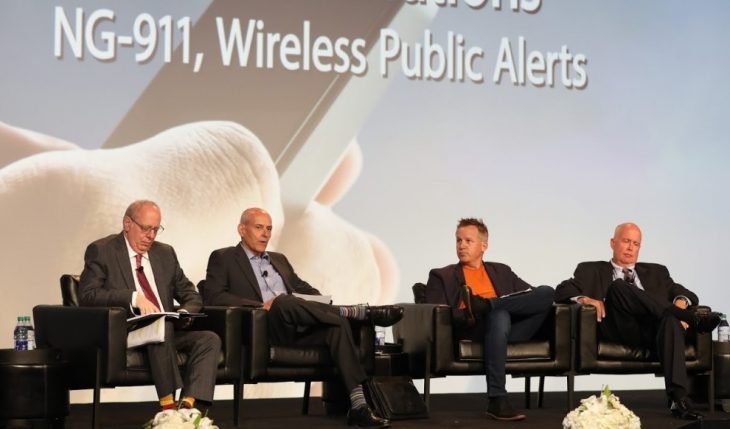
TORONTO – Rather than looking at next generation 9-1-1 like a plumbing project that is necessary and uninspiring, “we should be inspired by disruptors and ought to consider how to use the 9-1-1 brand to propagate safety and security,” Don Ferguson told the Canadian Telecom Summit audience on Tuesday.
Ferguson, the chief executive officer of tech provider NGA911, was part of panel convened to discuss the evolution of emergency communications. Moderated by telecommunications consultant Ed Antecol, the panel also included Paul Temple, senior vice-president of regulatory and strategic affairs at Pelmorex (which runs Canada’s emergency alerting service), and Peter White, AVP of global public policy at AT&T.
“This is a huge opportunity,” said Ferguson, referring to the planned upgrade of the 9-1-1 emergency response system that first went into development in 1972. He noted that despite all the innovation in the world since 1972, such as sequencing the human genome, “9-1-1 is still a voice call to a dispatcher.
“We should be inspired to turn it from a simple voice call system to something innovative and maybe even awe-inspiring.”
He equated the existing and aged voice-call system to trying to help someone while blindfolded and advocated strongly for a new system that includes instant messaging, video and streaming. Visual information about an assailant, a fire or about an ill person’s symptoms could provide first responders with added assistance. This is something the CRTC, telecom providers, emergency services and governments are working towards.
White noted that in the United States, the system will support 360-character messaging by 2019 and should also have improved geo-targeting, down to 1/10 mile from the current county level. However, it is challenging, given that authorities at various levels of government are involved in implementing 9-1-1. He also highlighted the financial challenge of updating 9-1-1.
“If you are going to build a more powerful system, you need a more powerful funding system, and that is a work in progress,” he said.
Temple hails from the parent company of the Weather Network, which operates Canada’s National Public Alert System. He talked about the evolution of a system that provided alerts only via radio and television to one that has now expanded to wireless alerts, albeit with some hiccups. The CRTC required Pelmorex to test the upgraded system recently during Emergency Preparedness Week. A coding error prevented the test from running smoothly.
“It certainly created awareness,” Temple said. “Many people were upset because they didn’t get the alert and the others were upset because they did.”
All humour aside, he said testing in a live environment is crucial to uncover flaws in the system. One of the challenges is to educate the public. They need to have the proper mobile software and must understand what receiving an alert indicates. “A lot of authorities only used the system when there was a threat to life,” Temple said. “The system is now being used in 10 different situations across the provinces: in Alberta, it is used for wildfires and flash floods, for example” as well as Amber Alerts.
“The kids use Snapchat, which speaks IM (instant messaging) and has no 9-1-1 support. NextGen 9-1-1 should be able to accept messages in all kinds of formats, but this isn’t yet addressed.” – Don Ferguson, NGA911
He said that at present, the authority issuing the alert has no ability to choose a destination; it automatically is put out over all channels. Pelmorex is developing the option of delivering messages to broadcast-only, wireless-only or both. The company also wants to capitalize on the system’s ability to localize alerts down to the level of cell sites.
“The wireless service providers need to put more effort into educating customers about receiving alerts, since they interact with these customers directly,” he said.
Turning back to 9-1-1, the panel discussed whether texting your emergency to 9-1-1, rather than calling it in, was helpful. This feature is available in the U.S., but, in Canada, texts are only allowed for hearing-impaired people who must first call anyway to activate the text feature.
“One thing that concerns me,” said White, “is that there are a large number of people without 4G LTE handsets who can’t do it.”
Ferguson expressed concern that this technology isn’t well-adapted to the younger generation.
“SMS (standard message system) use is dwindling,” he said. “The kids use Snapchat, which speaks IM (instant messaging) and has no 9-1-1 support. NextGen 9-1-1 should be able to accept messages in all kinds of formats, but this isn’t yet addressed.”
“Seamless interoperability should be the goal that everyone is working toward,” added White. “There is a need for intensive, inclusive discussion on how to do that.”



